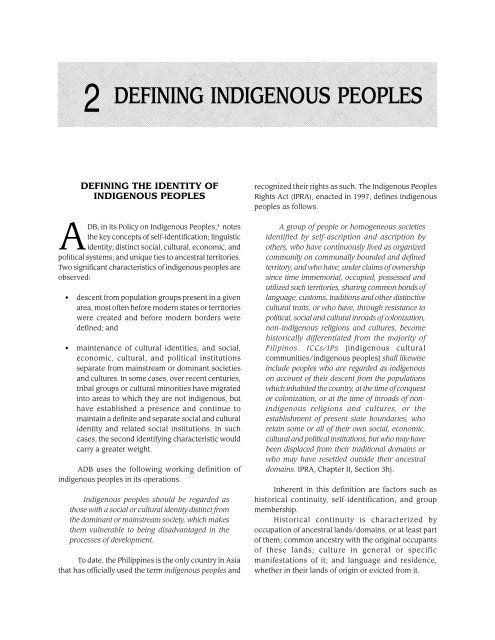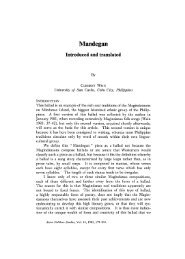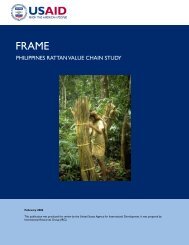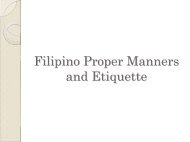Phils Prelim - Ethnic Filipinos, Indigenous & Tribal Groups
Phils Prelim - Ethnic Filipinos, Indigenous & Tribal Groups
Phils Prelim - Ethnic Filipinos, Indigenous & Tribal Groups
You also want an ePaper? Increase the reach of your titles
YUMPU automatically turns print PDFs into web optimized ePapers that Google loves.
Poverty Assessment in the <strong>Indigenous</strong> Communities of the Cordillera Region 32DEFINING INDIGENOUS PEOPLESDEFINING THE IDENTITY OFINDIGENOUS PEOPLESrecognized their rights as such. The <strong>Indigenous</strong> PeoplesRights Act (IPRA), enacted in 1997, defines indigenouspeoples as follows.ADB, in its Policy on <strong>Indigenous</strong> Peoples, 4 notesthe key concepts of self-identification; linguisticidentity; distinct social, cultural, economic, andpolitical systems; and unique ties to ancestral territories.Two significant characteristics of indigenous peoples areobserved:• descent from population groups present in a givenarea, most often before modern states or territorieswere created and before modern borders weredefined; and• maintenance of cultural identities; and social,economic, cultural, and political institutionsseparate from mainstream or dominant societiesand cultures. In some cases, over recent centuries,tribal groups or cultural minorities have migratedinto areas to which they are not indigenous, buthave established a presence and continue tomaintain a definite and separate social and culturalidentity and related social institutions. In suchcases, the second identifying characteristic wouldcarry a greater weight.ADB uses the following working definition ofindigenous peoples in its operations.<strong>Indigenous</strong> peoples should be regarded asthose with a social or cultural identity distinct fromthe dominant or mainstream society, which makesthem vulnerable to being disadvantaged in theprocesses of development.To date, the Philippines is the only country in Asiathat has officially used the term indigenous peoples andA group of people or homogeneous societiesidentified by self-ascription and ascription byothers, who have continuously lived as organizedcommunity on communally bounded and definedterritory, and who have, under claims of ownershipsince time immemorial, occupied, possessed andutilized such territories, sharing common bonds oflanguage, customs, traditions and other distinctivecultural traits, or who have, through resistance topolitical, social and cultural inroads of colonization,non-indigenous religions and cultures, becomehistorically differentiated from the majority of<strong>Filipinos</strong>. ICCs/IPs [indigenous culturalcommunities/indigenous peoples] shall likewiseinclude peoples who are regarded as indigenouson account of their descent from the populationswhich inhabited the country, at the time of conquestor colonization, or at the time of inroads of nonindigenousreligions and cultures, or theestablishment of present state boundaries, whoretain some or all of their own social, economic,cultural and political institutions, but who may havebeen displaced from their traditional domains orwho may have resettled outside their ancestraldomains. IPRA, Chapter II, Section 3h).Inherent in this definition are factors such ashistorical continuity, self-identification, and groupmembership.Historical continuity is characterized byoccupation of ancestral lands/domains, or at least partof them; common ancestry with the original occupantsof these lands; culture in general or specificmanifestations of it; and language and residence,whether in their lands of origin or evicted from it.
4<strong>Indigenous</strong> Peoples/<strong>Ethnic</strong> Minorities and Poverty Reduction: PhilippinesThe concept of self-identification is inextricablyrelated to group membership, identity, and history. Thethread that weaves these factors together is theindigenous peoples’ attachment to land and territory.NEGOTIATING IDENTITIESDespite efforts to define indigenous peoples,there is still no consensus as to exactly who are theindigenous peoples in the Philippines. This is due tothe absence of up-to-date cultural mapping in thiscountry. Another reason is the tenuous way in whichindigenous peoples’ identities have been constructedby themselves and others (for political, religious, andother reasons). This problem of “contesting identities”is best illustrated in the case of the indigenous peoplesin Mindanao.It is not easy to label the identities of peoples ofthe geographic region known as Mindanao, since thecriteria for doing so are not fixed. Even supposedlymonolithic categories such as “Moro” are not immutable.Political expression of the Moro as an identity hasundergone some variations in recent years. There arealso other overlapping layers of identities that cut acrossethnic and religious boundaries. Thus, the best that canbe achieved is an attempt at categorizing peoples basedon (mostly) external criteria, rather than selfidentification.The dichotomy between Moro and Lumad is ahistorical creation—i.e., a result of the process ofIslamization. Until now, common origin stories aboundamong Muslims and Lumads. In their folklore, Muslimand nonMuslim groups claim the same ancestry. Forexample, the oral literature of the Subanen ofZamboanga refers to four legendary brothers:Tabunaway, who brought forth the Maguindanao;Dumalandan, who sired the Maranao; Mili-irid, whobegot the Tiruray; and Gumabon-gabon who was theancestor of the Subanen. 5The Manobo and Maguindanao of the formerCotabato Province recount the story of the brothersTabunaway and Mamalu, who were their commonancestors. In the Manobos version of the story, they alsoshare the same ancestor as the Ilyanun, the Matigsalug,the Talandig, and the Maranaw. Tiruray legends alsospeak of Tabunaway and Mamalu as their ancestors. 6The introduction of Islam split the peoples ofMindanao into two distinct categories, Moros andLumads. Those who adopted Islam became the Morosand those who did not became the Lumads, a Visayanterm which means “born of the earth.” Lumads areregarded as the original inhabitants of Mindanao. Lumadalso now refers to the nonMuslim, nonChristianindigenous peoples of Mindanao.There are at least 13 Islamized ethnolinguisticgroups indigenous to Mindanao. 7 They are the Maranaw,Maguindanao, Tausug, Yakan, Samal, Sangil, Molbog,Kalibugan, Kalagan, Palawani, Iranun, Jama Mapun, andthe Badjao.The 18 nonMuslim or Lumad groups are theBagobo of Davao del Sur, South and North Cotabato,and Sultan Kudarat; Mansaka of Davao del Norte;Mandaya of Davao Oriental; Subanen of the ZamboangaPeninsula; B’laan of Davao del Sur, South Cotabato,North Cotabato, Maguindanao, and Sultan Kudarat;T’boli of South Cotabato; and Tiruray of North Cotabato,Maguindanao and Sultan Kudarat.The Manobo encompass various tribes that arealso considered Lumad because they are found inMindanao—in Agusan del Sur and Norte, Davao, andCotabato.Other Manobo tribes include the Higaonon ofAgusan and Misamis Oriental; Bukidnon of Bukidnonand Misamis Oriental; Talaandig of Bukidnon;Matigsalug of Bukidnon and Davao del Sur; Umayamnonof Agusan and Bukidnon; Dibabawon of Agusan andDavao; Banwaon of Agusan and Misamis Oriental;Talaingod of Davao del Norte; Tagakaolo of Davao Sur;Ubo of South Cotabato; Tasaday of South Cotabato; B’litof South Cotabato; and Mangguangan of Davao delNorte and Sur, and Cotabato.In Mindanao society, ethnic identity forms the coreof all other layers of socially constructed identities. Anindividual is identified first by his or her ethnic affiliation.Religion is now also a key element in the differentiationand construction of these identities. Through the years,many members of the ethnolinguistic groups haveadopted Islam as a way of life. Some converted toChristianity, while others, the Lumads, held on to theirindigenous beliefs, practices, and traditions.The terms Muslim and Moro have been usedinterchangeably to refer to those people who haveadopted Islam as a religion and a way of life. However,Muslim refers to a universal religious identity, while Moro
Defining <strong>Indigenous</strong> Peoples 5denotes a political identity distinct to the Islamizedpeoples of Mindanao and Sulu. The Spanish colonizersoriginally used the term for peoples of Mindanao whoshared the religion of the Moors who had once colonizedSpain. The term Moro was used in the same derogatoryway as the term Indio for <strong>Filipinos</strong> from Luzon and theVisayas whom they converted to Christianity. 8From the late 1960s through the early 1970s, Morointellectuals reclaimed the term Moro in their efforts to“imagine” a distinct Moro identity. Triggered by theJabida massacre of 1968, among others, Morointellectuals led by Nur Misuari created and popularizedthe Bangsamoro identity. Bangsamoro became aninspiration, a concept that connoted a peoples’ sharedidentity and vision for a new nation. Such claims tonationhood may not be validated by historical evidence,but the term has gained cogency and acceptance. It hasinspired among members of Muslim society a subjectivefeeling of being one. It has also assumed the followingcharacteristics: it is anticolonial and inspired by atradition of resistance, it is anti-elite, it is distinctlyIslamic, and it is rooted in a struggle for justice. 9The Moros expressed their consciousness of anation through a political struggle for self-determinationand in 1969 formed the Moro National Liberation Front(MNLF).Islam is central to the development of Moroidentity. It serves to unite the 13 ethnolinguistic groupsthat form the so-called “Moro Nation.” By interfacingreligious doctrines and (Moro) nationalist ideas, the goalto establish the Moro Nation became necessarily a goalto preserve Islam and Islamic culture. 10In the 1980s, the project to build a Bangsamorobegan to manifest some cracks. The Moro politicalstruggle was divided by two opposing concepts of MoroNationalism. On the one hand, MNLF Chairman NurMisuari, albeit a devout Muslim, advocated a secularbrand of leadership. For him, the role of the MNLF wasto uphold social justice and to lead the Moros out oftheir economic and social ruin. Misuari’s goal was“modernist,” and was grounded on liberal and politicalthought.On the other hand, Hashim Salamat posited thatIslam is the primary source of legitimacy of their struggle,and matters of faith and political leadership are notseparate realms. He further argued that theBangsamoro’s only guarantee for success is inspirationand guidance from the Koran and Islamic rules. For him,leaders should be religious scholars who can apply thecorrect strategy and directions for the struggle, basedon the Koranic scriptures. In 1984, Salamat left the MNLFto form another organization, the Moro IslamicLiberation Front (MILF).Political analyst and journalist Eric Gutierrez 11succinctly analyzed the cause of the factionalism, thus.At the root of the MNLF-MILF debates are theirdiffering notions of Moro identity. The modernistMNLF adheres to an inclusive definition of thatidentity (including non-Muslim Christians andLumads); while the MILF, on the other hand, adhereto a definition that proposes greater exclusivity forthe Muslims. Although it tends to accommodategroups whose existence cannot be denied, therebyconfirming the increasing diversification ofcommunity life and individual experiences, theMILF strives for moral consensus, internal cohesionand standardization of fundamental beliefs andvalues within the framework of Islam.Where do indigenous peoples or Lumads standamid these acrimonious debates? As may be gleanedin the above quote, both the MNLF and MILF dorecognize the existence of Lumads. However, becauseof the claim for nationhood and the need to rally allBangsamoro to a single national identity, the MILF andMNLF have not been very active in highlighting ethnicidentities, to the point of dismissing the issue asirrelevant at this point.Neither the MNLF nor MILF has clearly articulateda program for asset redistribution, including theindigenous peoples’ demand with regard to theirancestral lands. This issue is potentially and actually anexplosive one, especially in Mindanao. In the recentpeace negotiations, the MILF has listed the recognitionof ancestral domain as a primary item in their agenda.Meanwhile, the indigenous peoples of Mindanaohave become more self-conscious and increasinglyvigilant of their rights. On 17–19 January 2001, some 67Lumad men and women leaders from 20 ethnic groupsheld a “Mindanao <strong>Indigenous</strong> Peoples Peace Forum” inDavao City. The gathering produced an <strong>Indigenous</strong>Peoples Peace Agenda, which they addressed to thegovernment’s Armed Forces of the Philippines, the MILF,and the New People’s Army (a communist militantgroup). The statement included the following demands.
6<strong>Indigenous</strong> Peoples/<strong>Ethnic</strong> Minorities and Poverty Reduction: Philippinesa. That the Lumad population be sufficientlyrepresented in any peace negotiation inMindanao, especially in negotiations with theMILF and the NDF (National Democratic Front).The Government, however, should give specialsupport to local initiatives on conflict resolutionand transformation, like the local declaration ofLumad territories as Peace Zones.b. That the Senate and the House ofRepresentatives should pass a law declaring theterritories of the Lumads as autonomous. Thisshould include the Lumad territories within theAutonomous Region in Muslim Mindanao(ARMM).c. That all concerned should recognize and respectthe territories and boundaries established by theelders during the D’yandi and Pakang times. 12 Thisincludes territorial agreements among Lumadtribes, between Lumads and the Moros, andbetween Lumads and Christian settlers.d. That all concerned should respect our beliefs andpractices and our ways of modifying them in theface of Islamic and Christian doctrines andpractices, as well as the impact of globalization.e. That the Government should protect Lumadterritories from the incursion of mining,plantations, and other projects that threaten thetribes and their environment.f. That local government units should passordinances, and even release additional funds, ifpossible, to reinforce the provisions and fullimplementation of the IPRA.g. That the liberating forces of the IPRA againstdiscrimination be reinforced through joint effortsof schools, churches, the media, and otherinstitutions.The whole concept of Bangsamoro may also bedebated in the light of demographic changes inMindanao in recent years. As of 1990, there were morenonMuslim (81% of the total population) than Morooccupants (19%) of the Moro terrirory, which is generallyconsidered to include the 14 provinces and 9 citiescovered by the 1976 Tripoli Agreement and the 1996Peace Agreement. Due to past government efforts tomove settlers into the region, it is not surprising to findIlonggo, Cebuano, Tagalog, or Ilocano speakers in oneneighborhood with a mixture of Maranaw, Tausog,Maguindanao, and Arabic speakers. Small ethnicgroupings, like the B’laan, T’boli, and Manobo, have theirown distinct languages as well. Only 5 provinces (Sulu,Tawi-Tawi, Basilan, Lanao del Sur, and Maguindanao)and one city (Marawi) remain “Muslim enclaves.” Thesedemographic changes present a major political dilemmafor a wider definition of “Moro areas.”In the 1990s, the concept of tri-people gained widediscussion in civil society. This concept attempts tograpple with the Mindanao’s multiethnic, multipeopleidentity. The tri-people refers to three peoples: themajority Filipino Christian settlers, the Lumads, and theMoros. The concept has been used “not only to describethis diversity, but more importantly, in recognition of ahistorical process of unification.” 13 The tri-peopleconcept presupposes that the Christians, Moros, andLumads consist of three distinct peoples. Thus, theMaguindanao, Maranaw, Tausug, and other Muslimtribes are collectively called the Moro people. TheHigaonon, Subanen, Tiduray, T’boli, and othernonMuslim tribes are collectively called Lumads. Thoseamong them who have converted to Christianity arecalled Christians.The construction of identities of the peoples ofMindanao continues. Certainly, these identities will beinvented and reinvented amid demographic changes,political exigencies, and religious dimensions. But onething seems constant: the ethnic dimension of identity.<strong>Ethnic</strong>ity will persist as a central axis of this evolvingidentity—even beyond the completion of the so-calledBangsamoro project.
















